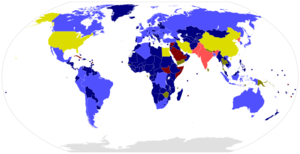Difference between revisions of "Comprehensive Nuclear Test Ban Treaty"
(Inaugurating) |
(Added: locations.) |
||
| Line 4: | Line 4: | ||
|image_caption=Participation in the [[CTBT]] | |image_caption=Participation in the [[CTBT]] | ||
|wikipedia=https://en.wikipedia.org/wiki/Comprehensive_Nuclear-Test-Ban_Treaty | |wikipedia=https://en.wikipedia.org/wiki/Comprehensive_Nuclear-Test-Ban_Treaty | ||
| + | |locations=New York City | ||
}} | }} | ||
The '''Comprehensive Nuclear Test Ban Treaty''' ('''CTBT''') is a multilateral treaty that bans all nuclear explosions, for both civilian and military purposes, in all environments. It was adopted by the [[United Nations General Assembly]] on 10 September 1996 but has not entered into force as eight specific states have not ratified the treaty.<ref>''[https://fas.org/nuke/control/ctbt/chron1.htm "Comprehensive Test Ban Treaty Chronology"]''</ref> | The '''Comprehensive Nuclear Test Ban Treaty''' ('''CTBT''') is a multilateral treaty that bans all nuclear explosions, for both civilian and military purposes, in all environments. It was adopted by the [[United Nations General Assembly]] on 10 September 1996 but has not entered into force as eight specific states have not ratified the treaty.<ref>''[https://fas.org/nuke/control/ctbt/chron1.htm "Comprehensive Test Ban Treaty Chronology"]''</ref> | ||
Revision as of 13:30, 11 July 2017
 Participation in the CTBT | |
| Location | New York City |
|---|---|
The Comprehensive Nuclear Test Ban Treaty (CTBT) is a multilateral treaty that bans all nuclear explosions, for both civilian and military purposes, in all environments. It was adopted by the United Nations General Assembly on 10 September 1996 but has not entered into force as eight specific states have not ratified the treaty.[1]
Participation
The CTBT was adopted by the UN General Assembly on 10 September 1996. It opened for signature in New York on 24 September 1996,[2] when it was signed by 71 States, including five of the eight then nuclear-capable states. As of October 2016, 166 states have ratified the CTBT and another 17 states have signed but not ratified it.[3][4]
The CTBT will enter into force 180 days after the 44 states listed in Annex 2 of the treaty have ratified it. These "Annex 2 states" are states that participated in the CTBT’s negotiations between 1994 and 1996 and possessed nuclear power reactors or research reactors at that time.[5]
Laggard states
Eight Annex 2 states have not ratified the CTBT:
- China
- Egypt
- Iran
- Israel and the
- United States have signed but not ratified the Treaty;
- India
- North Korea and
- Pakistan have not signed it.[6]
Related Document
| Title | Type | Publication date | Author(s) | Description |
|---|---|---|---|---|
| Document:Labour Built the Bomb | Article | 10 July 2017 | Bill Ramsay | The prompt for this short essay is not Labour's nuclear legacy: it is what took place in the UN General Assembly last Friday when the Nuclear Weapon Ban Treaty passed into international law. |
References
- ↑ "Comprehensive Test Ban Treaty Chronology"
- ↑ United Nations Treaty Collection (2009). "Comprehensive Nuclear-Test-Ban Treaty", Retrieved 23 August 2009.
- ↑ "Status of Signature and Ratification". Preparatory Commission for the Comprehensive Nuclear-Test-Ban Treaty Organisation. 2011. Retrieved 20 September 2011.Page Module:Citation/CS1/styles.css must have content model "Sanitized CSS" for TemplateStyles (current model is "Scribunto").
- ↑ David E. Hoffman (1 November 2011), "Supercomputers offer tools for nuclear testing — and solving nuclear mysteries", The Washington Post; National, retrieved 30 November 2013Page Module:Citation/CS1/styles.css must have content model "Sanitized CSS" for TemplateStyles (current model is "Scribunto").
In this news article, the number of states ratifying was reported as 154. - ↑ "The Russian Federation's support for the Comprehensive Nuclear-Test-Ban Treaty". CTBTO Preparatory Commission. 2008. Archived from the original on 27 September 2011. Retrieved 4 December 2011. Cite uses deprecated parameter
|deadurl=(help)Page Module:Citation/CS1/styles.css must have content model "Sanitized CSS" for TemplateStyles (current model is "Scribunto"). - ↑ "STATE DEPARTMENT TELEGRAM 012545 TO INTSUM COLLECTIVE, "INTSUM: INDIA: NUCLEAR TEST UNLIKELY"". Nuclear Proliferation International History Project.Page Module:Citation/CS1/styles.css must have content model "Sanitized CSS" for TemplateStyles (current model is "Scribunto").